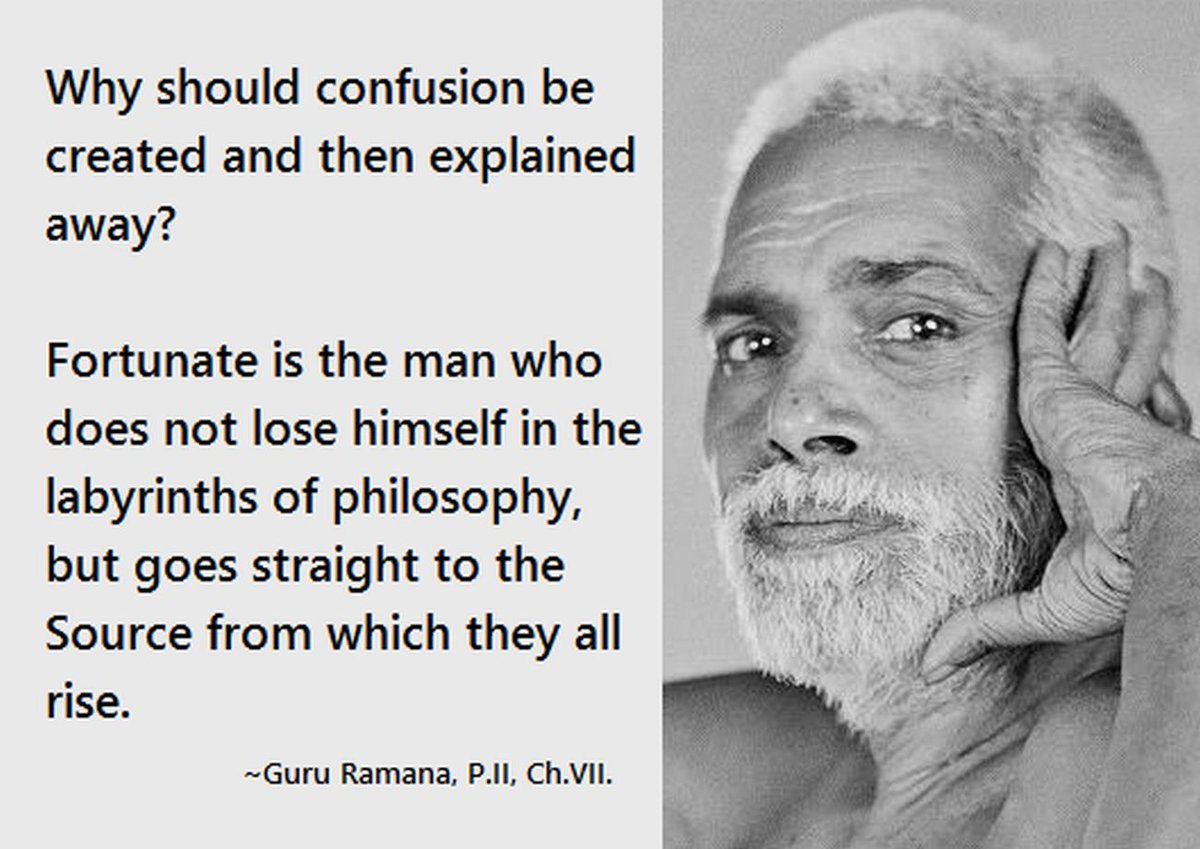
Hawkins / RamanaMaharshi
Inhaltsverzeichnis: (verbergen)
|
Der erleuchtete Weise Ramana Maharshi lehrte, dass man mit einem Rajas-orientierten Geist/Gemüt nicht fähig sei zu meditieren. Ein ruhiger Geist ist in der Lage, sich der Medi-
Zur Selbsterforschung dienen beispielsweise Fragen dieser Art: |
| Siehe auch: ► Das Ego überschreiten und heilen |
Wer bin ich? Sri Ramana Maharshi, erstellt von Dr. T. M. P. Mahadevan, Der Weg der Selbstverwirklichung, Juni 1982
"Wer bin ich?" ist der Titel einer Sammlung von Fragen und Antworten rund um das Thema "Selbst-Erkenntnis". Der Philosoph Sri Pillai richtete 1902 vierzehn Fragen an Ramana Maharshi. Statt zu antworten, verständigte sich der schweigende Ramana nur mit Gesten.
Wer bin ich? gilt als Meister Ramanas Sammlung von Anweisungen auf dem nicht einfachen Weg ihrer Selbsterkenntis an sei-
ne Schüler. Wer der Frage "Wer bin ich?" konsequent nachgeht, hebt das Gedankenbilden auf, wodurch schließlich der "Ich-Gedanke" an sich verschwindet. Bestand hat das dauerhafte "nicht-dualistische" und Alle und Alles umfassende Selbst, die Schau Gottes als Erfahrung der Absolutheit.
Die vollkommene Realität des Seins ohne den "Ich-Gedanken" gilt auch als die Erfahrung der "Stille".
| Entnommen aus: Self Enquiry Dr. T. M. P. Mahadevan, Prahlad.org, Juni 1982 |
The master is within…
Talks with Sri Ramana Maharshi. On Realizing Abiding Peace and Happiness, Sri Ramanasramam Tiruvannamalai, India, 1955, 1962, Inner Directions, 2nd edition 1. August 2000
Who Am I?

Be As You Are. The Teachings of Sri Ramana Maharshi, David Godman, editor, Penguin, reissue 1. Februar 1989
The Collected Works
Letters
"The Mountain Path"
The essential teachings of Ramana Maharshi. A Visual Journey, Inner Directions, 1. January 2002
Heart is Thy Name, Oh Lord. Moments of Silence with Sri Ramana Maharshi, Sri Ramanasramam, December 2004
The Spiritual Teaching of Ramana Maharshi, Shambhala Dragon Books, 1988, new edition 10. August 2004
Maharshi's Gospel
The Gospel of Thomas in the Light of Ramana Maharshi
The Teachings of Sri Ramana Maharshi – Karma and Destiny Preamble
Gems from Bhagavan
Abide As The Self
Ramana Maharshi and the Path of Self-Knowledge
|
Personal avowals
Ramana Maharshi experienced his own death at age 16 which was the moment of enlightenment to him. He left home and lived in an ashram to adjust to his state. He lived in complete silence. Months later his mother came to visit him while he is sitting in meditation. She cries to bring him back home. Ramana does not utter a word. Finally his disciples asked him to please at least write a note to his weeping mother. He complied and wrote:
She read the message and left. Years later she returned to his ashram and lived with him for six years (cooking for him).
She found bliss in his arms before she died.
One of the devotees described the distress many of them felt for the tumour that Ramana Maharshi had on his arm. At one point they begged him to give the cancer to his devotees instead, to keep him free of pain. To that offer Ramana lovingly re-
plied: 'Where do you think I got this from in the first place?', explaining that the tumour was the condensed manifestation of
the negative karma he had taken from his devotees in order to help them process it.
He assured his disciples: "I am not going anywhere, where shall I go? I shall be there where I am always."1
Sitting in lotus position, Ramana died of stomach cancer in April 1950.
| Source: ► The Power of the Presence – 3 book collection of accounts of the people who lived closest to the Maharshi |
| See also: ► Sainted and enlightened ones died as a result of severe diseases. |
Links zum Thema Ramana MaharshiLiteratur
Literature (engl.)
Externe Weblinks
External web links (engl.)
Audio- und VideolinksAudio and video links (engl.)
Old and new still photographs, excerpts from Ramana's writings, interviews with longtime devotees, and rare and precious footage of Ramana (1935-1949)
|
Wiki-Ebene